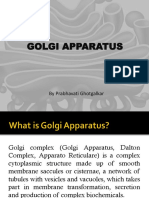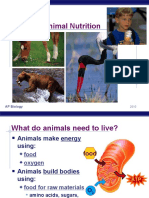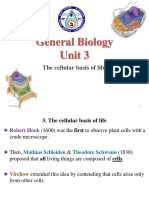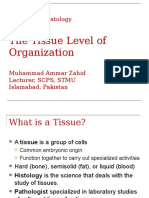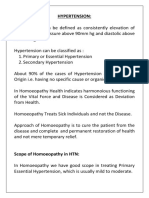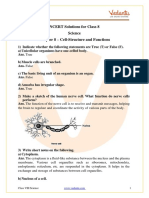Professional Documents
Culture Documents
Dictyosome: Modifying, and Packaging Proteins and Lipids Into Vesicles For
Uploaded by
ASHFAQ AHMAD100%(1)100% found this document useful (1 vote)
704 views11 pagesOriginal Title
08 Dictyosomes
Copyright
© © All Rights Reserved
Available Formats
PPTX, PDF, TXT or read online from Scribd
Share this document
Did you find this document useful?
Is this content inappropriate?
Report this DocumentCopyright:
© All Rights Reserved
Available Formats
Download as PPTX, PDF, TXT or read online from Scribd
100%(1)100% found this document useful (1 vote)
704 views11 pagesDictyosome: Modifying, and Packaging Proteins and Lipids Into Vesicles For
Uploaded by
ASHFAQ AHMADCopyright:
© All Rights Reserved
Available Formats
Download as PPTX, PDF, TXT or read online from Scribd
You are on page 1of 11
Dictyosome
• The Golgi apparatus is an organelle present in most eukaryotic
cells. It is made up of membrane-bound sacs, and is also called
a Golgi body, Golgi complex, or dictyosome.
• Golgi apparatus, also called Golgi complex or Golgi body,
membrane-bound organelle of eukaryotic cells (cells with
clearly defined nuclei) that is made up of a series of flattened,
stacked pouches called cisternae.
• The Golgi apparatus is responsible for transporting,
modifying, and packaging proteins and lipids into vesicles for
delivery to targeted destinations.
• It is located in the cytoplasm next to the endoplasmic
reticulum and near the cell nucleus. While many types of cells
contain only one or several Golgi apparatus, plant cells can
contain hundreds.
• In general, the Golgi apparatus is made up of approximately
four to eight cisternae, although in some single-celled
organisms it may consist of as many as 60 cisternae.
• The cisternae are held together by matrix proteins, and the
whole of the Golgi apparatus is supported by cytoplasmic
microtubules.
• The apparatus has three primary compartments, known
generally as “cis” (cisternae nearest the endoplasmic
reticulum), “medial” (central layers of cisternae), and “trans”
(cisternae farthest from the endoplasmic reticulum).
• Two networks, the cis Golgi network and the trans Golgi
network, which are made up of the outermost cisternae at the
cis and trans faces, are responsible for the essential task of
sorting proteins and lipids that are received (at the cis face) or
released (at the trans face) by the organelle.
• The proteins and lipids received at the cis face arrive in
clusters of fused vesicles. These fused vesicles migrate along
microtubules through a special trafficking compartment, called
the vesicular-tubular cluster, that lies between the endoplasmic
reticulum and the Golgi apparatus.
• When a vesicle cluster fuses with the cis membrane, the
contents are delivered into the lumen of the cis face cisterna.
• As proteins and lipids progress from the cis face to the trans
face, they are modified into functional molecules and are
marked for delivery to specific intracellular or extracellular
locations.
• Some modifications involve cleavage of oligosaccharide side
chains followed by attachment of different sugar fractions in
place of the side chain. Other modifications may involve the
addition of fatty acids or phosphate groups (phosphorylation)
or the removal of monosaccharides.
• The different enzyme-driven modification reactions are
specific to the compartments of the Golgi apparatus. For
example, the removal of mannose moieties occurs primarily in
the cis and medial cisternae, whereas the addition of galactose
or sulfate occurs primarily in the trans cisternae.
• In the final stage of transport through the Golgi apparatus,
modified proteins and lipids are sorted in the trans Golgi
network and are packaged into vesicles at the trans face.
• These vesicles then deliver the molecules to their target
destinations, such as lysosomes or the cell membrane.
• Some molecules, including certain soluble proteins and
secretory proteins, are carried in vesicles to the cell membrane
for exocytosis (release into the extracellular environment).
• The exocytosis of secretory proteins may be regulated,
whereby a ligand must bind to a receptor to trigger vesicle
fusion and protein secretion.
The vesicular transport model
This model is based on the idea that vesicles bud off and fuse to cisternae
membranes, thus moving molecules from one cisterna to the next; budding
vesicles can also be used to transport molecules back to the endoplasmic
reticulum.
A vital element of this model is that the cisternae themselves are stationary. In
contrast, the cisternal maturation model depicts the Golgi apparatus as a far
more dynamic organelle than does the vesicular transport model.
The cisternal maturation model indicates that cis cisternae move forward
and mature into trans cisternae, with new cis cisternae forming from the fusion
of vesicles at the cis face. In this model, vesicles are formed but are used only
to transport molecules back to the endoplasmic reticulum.
Other examples of models to explain protein and lipid movement through the
Golgi apparatus include the rapid partitioning model, in which the Golgi
apparatus is viewed as being divided into separately functioning
compartments (e.g., processing versus exporting regions), and the stable
compartments as cisternal progenitors model, in which compartments within
the Golgi apparatus are considered to be defined by Rab proteins.
• The Golgi apparatus was observed in 1897 by Italian
cytologist Camillo Golgi.
• In Golgi’s early studies of nervous tissue, he had established a
staining technique that he referred to as reazione nera,
meaning “black reaction”; today it is known as the Golgi stain.
• In this technique nervous tissue is fixed with potassium
dichromate and then suffused with silver nitrate. While
examining neurons that Golgi stained using his black reaction,
he identified an “internal reticular apparatus.”
• This structure became known as the Golgi apparatus, though
some scientists questioned whether the structure was real and
attributed the find to free-floating particles of Golgi’s metal
stain. In the 1950s, however, when the electron microscope
came into use, the existence of the Golgi apparatus was
confirmed.
Camillo Golgi, 1906.Courtesy of the Wellcome Trustees, London
The Function of Golgi Apparatus
• The job of the Golgi apparatus is to process macromolecules
like proteins and lipids as they are synthesized within the cell.
• The Golgi apparatus is sometimes compared to a post office
inside the cell since one major function is to modify, sort, and
package proteins to be secreted.
• The Golgi apparatus is made up of sacs called cisternae.
Usually five to eight cisternae are present in one Golgi
apparatus, but as high a number as sixty cisternae have been
observed by scientists.
• These bundles of sacs have five distinct and functional
regions, and each region has different enzymes to help it
modify the contents, depending on where they are to end up.
• This organelle is also important in other ways, specifically in
the transport of lipids throughout the cell and the creation of
lysosomes.
• The Golgi complex works closely with the rough ER. When
the ER makes a protein, a transition vesicle is also made. It
drifts through the cytoplasm to the Golgi apparatus where it
gets absorbed. After the Golgi works on the molecules inside,
it secretes a vesicle into the cytoplasm which releases the
protein molecule out of the cell.
You might also like
- Golgi Apparatus MypptDocument16 pagesGolgi Apparatus MypptPrabhavati Ghotgalkar100% (1)
- Lec 3,4,5-Cell and Cell OrganellesDocument57 pagesLec 3,4,5-Cell and Cell OrganellesSatyam AryaNo ratings yet
- Phloem LectureDocument23 pagesPhloem LectureNurlia Khofiyya100% (2)
- CytologyDocument20 pagesCytologykaziba stephen100% (1)
- The Golgi ApparatusDocument10 pagesThe Golgi ApparatusRakesh KumarNo ratings yet
- Chlorophyceae: VolvoxDocument13 pagesChlorophyceae: VolvoxAnilNo ratings yet
- Endoplasmic ReticulumDocument8 pagesEndoplasmic ReticulumShahab Saqib KhanNo ratings yet
- Chapter6-Phylum Porifera NotesDocument4 pagesChapter6-Phylum Porifera Notesapi-195601294No ratings yet
- Cell Cycle Regulation CheckpointsDocument23 pagesCell Cycle Regulation CheckpointsShikhaj ArmaanNo ratings yet
- 5 Metzeriales PDFDocument7 pages5 Metzeriales PDFnabin sharmaNo ratings yet
- Animal Nutrition: AP BiologyDocument34 pagesAnimal Nutrition: AP BiologyDoods Galdo100% (1)
- Plant and Animal TissuesDocument7 pagesPlant and Animal Tissueskapil100% (1)
- Class MusciDocument18 pagesClass MusciElaine BriososNo ratings yet
- RegenerationDocument17 pagesRegenerationtiestonNo ratings yet
- Alpha Domain StructureDocument35 pagesAlpha Domain StructureRekha Govindan100% (1)
- Volvox--The Spherical Freshwater Colony of ChlorophytaDocument6 pagesVolvox--The Spherical Freshwater Colony of ChlorophytaArista Novi Hana PratiwiNo ratings yet
- Flowers: Sexual Reproduction in AngiospermsDocument106 pagesFlowers: Sexual Reproduction in AngiospermsAlfonso PlantillaNo ratings yet
- 02a SEXUAL REPRODUCTION IN FLOWERING PLANTSDocument35 pages02a SEXUAL REPRODUCTION IN FLOWERING PLANTSRitik Kumar NayakNo ratings yet
- Ovary CultureDocument3 pagesOvary CultureSubha MaheswariNo ratings yet
- Respiration in Plants Class 11 QuestionsDocument3 pagesRespiration in Plants Class 11 QuestionsAshok KumarNo ratings yet
- Lecture 3 Chlorophyta: Algae DR - Ayad M.JDocument10 pagesLecture 3 Chlorophyta: Algae DR - Ayad M.JAura NazaNo ratings yet
- General CharactersDocument12 pagesGeneral CharactersKathirvel Gounder100% (1)
- Metamorphosis in InsectsDocument13 pagesMetamorphosis in InsectsAnupam GhoshNo ratings yet
- Oedogonium by Biology BombDocument8 pagesOedogonium by Biology BombNiroj Banik100% (1)
- 6.2 Cell Cycle and Mitosis (The Necessity of Mitosis For Living Organisms)Document32 pages6.2 Cell Cycle and Mitosis (The Necessity of Mitosis For Living Organisms)wickedbiology101No ratings yet
- Class: 8 Science Chapter - 8 Cell - Structure and FunctionsDocument10 pagesClass: 8 Science Chapter - 8 Cell - Structure and FunctionsAmiteshwar SinghNo ratings yet
- Cell Structure IDocument64 pagesCell Structure IDwi Puji Astini100% (1)
- Mammalian Histology AssignmentDocument9 pagesMammalian Histology AssignmentSana Sultana100% (1)
- Chloroplast NotesDocument4 pagesChloroplast NotesAnanda100% (1)
- Reproduction in AlgaeDocument57 pagesReproduction in AlgaeNarendra Kumar100% (1)
- Animal Kingdom: Basis of ClassificationDocument15 pagesAnimal Kingdom: Basis of ClassificationChaitali Deshmukh100% (1)
- Albugo: White Rust of CrucifersDocument34 pagesAlbugo: White Rust of CrucifersMuhammad MushtaqNo ratings yet
- Chapter 5 NotesDocument30 pagesChapter 5 NotestaengooNo ratings yet
- Notes - Growth and DevelopmentDocument4 pagesNotes - Growth and DevelopmentNathan mwapeNo ratings yet
- Structure Function CarbohydratesDocument28 pagesStructure Function Carbohydratespriya19866No ratings yet
- Metabolic Pathways of Carbohydrates LectureDocument5 pagesMetabolic Pathways of Carbohydrates LectureAj MondejarNo ratings yet
- 6 ProtozoaDocument40 pages6 ProtozoaMuhdori PadliNo ratings yet
- Organogenesis: By, BIRAC Innovation Fellow University of Agricultural Sciences, DharwadDocument24 pagesOrganogenesis: By, BIRAC Innovation Fellow University of Agricultural Sciences, DharwadTabada NickyNo ratings yet
- Lecture Two: Carbohydrate Lecture Two: CarbohydrateDocument24 pagesLecture Two: Carbohydrate Lecture Two: Carbohydratesaacid bashir100% (1)
- 8 & 9: Cell Structure and Function: CellsDocument13 pages8 & 9: Cell Structure and Function: CellsEnmuskNo ratings yet
- Class 12 Subject: Biology Chapter-2: FlowerDocument18 pagesClass 12 Subject: Biology Chapter-2: FlowerDianna josephNo ratings yet
- Lab Practical 1Document21 pagesLab Practical 1randy_sanchez_10No ratings yet
- Cells: A Basic IntroductionDocument18 pagesCells: A Basic IntroductionMuqadasNo ratings yet
- Unit 3 The Cellular Basis of LifeDocument41 pagesUnit 3 The Cellular Basis of LifeEbenezer AbrahamNo ratings yet
- Mitochondrial oxidative phosphorylation and the proton gradientDocument47 pagesMitochondrial oxidative phosphorylation and the proton gradientSadaf BegNo ratings yet
- Cell Cycle Cell Division PDFDocument13 pagesCell Cycle Cell Division PDFmuzamil shabir100% (1)
- Tissue Level of OrganizationDocument71 pagesTissue Level of OrganizationMuhammad Ammar100% (1)
- The Cell Cycle: Indian Institute of Technology PatnaDocument37 pagesThe Cell Cycle: Indian Institute of Technology PatnaHritik KumarNo ratings yet
- Spaced Learning Session 1 Life ProcessesDocument37 pagesSpaced Learning Session 1 Life Processesapi-210088695No ratings yet
- 05 Plant Structure and FunctionDocument87 pages05 Plant Structure and Functionapi-263663768100% (1)
- The Cell Cycle & Cell DivisionDocument30 pagesThe Cell Cycle & Cell DivisionamitNo ratings yet
- Vacuole 1Document14 pagesVacuole 1nadia riaz100% (1)
- CellDocument15 pagesCellprakash kushwahaNo ratings yet
- Porifera - EvolucionDocument9 pagesPorifera - EvolucionJuan David HPNo ratings yet
- The Cell Cycle and How Cells DivideDocument63 pagesThe Cell Cycle and How Cells DivideSrikanth KagithojuNo ratings yet
- Phylum Porifera NotesDocument2 pagesPhylum Porifera Notesapi-24708413675% (4)
- Prepared By: Lyle Alexandra MondaresDocument12 pagesPrepared By: Lyle Alexandra MondaresLyle Alexandra MondaresNo ratings yet
- PoriferaDocument39 pagesPoriferaabhishek.ajmaniNo ratings yet
- 2nd Q CEellDocument30 pages2nd Q CEellDeserie ZabalaNo ratings yet
- 4.the Golgi ApparatusDocument3 pages4.the Golgi ApparatusSabina MaharjanNo ratings yet
- Chapter Four Plant OrgansDocument76 pagesChapter Four Plant OrgansASHFAQ AHMADNo ratings yet
- AziyatDocument7 pagesAziyatASHFAQ AHMADNo ratings yet
- Laminar Air Flo-WPS OfficeDocument13 pagesLaminar Air Flo-WPS OfficeASHFAQ AHMADNo ratings yet
- Pioneer Forensics - PF001 - PF002 - Acetic Acid - GlacialDocument7 pagesPioneer Forensics - PF001 - PF002 - Acetic Acid - GlacialAndronikusNo ratings yet
- Computer Based Training & Distance Learning: University of Education, Vehari CampusDocument29 pagesComputer Based Training & Distance Learning: University of Education, Vehari CampusASHFAQ AHMADNo ratings yet
- 3.book of Assessment BS ProgramsDocument34 pages3.book of Assessment BS ProgramsASHFAQ AHMADNo ratings yet
- Computer Based Training & Distance Learning: University of Education, Vehari CampusDocument29 pagesComputer Based Training & Distance Learning: University of Education, Vehari CampusASHFAQ AHMADNo ratings yet
- 02 Cell WallDocument9 pages02 Cell WallASHFAQ AHMADNo ratings yet
- Class BivalviaDocument16 pagesClass BivalviaASHFAQ AHMADNo ratings yet
- Echinoderm CharactersiticsDocument8 pagesEchinoderm CharactersiticsASHFAQ AHMADNo ratings yet
- Samadhi Day Naqshbandi Sufi Onkar Nath - Bhaiyyaji RaDocument18 pagesSamadhi Day Naqshbandi Sufi Onkar Nath - Bhaiyyaji RaTaoshobuddhaNo ratings yet
- A Comparison of Sterofundin & RL On Intraoperative Acid Base & Electrolytes Status in Children (ACCM Journal)Document8 pagesA Comparison of Sterofundin & RL On Intraoperative Acid Base & Electrolytes Status in Children (ACCM Journal)TedyJaswadiNo ratings yet
- Chapter 6 - ESHE 365Document31 pagesChapter 6 - ESHE 365Encik Qiem100% (1)
- Anaemia in Pregnancy-HmDocument58 pagesAnaemia in Pregnancy-HmMazlina MaidinNo ratings yet
- Komunikasi B.inggris FiksDocument4 pagesKomunikasi B.inggris FiksEmii EmiiNo ratings yet
- Psoriasis Types Causes Medication I To 13Document189 pagesPsoriasis Types Causes Medication I To 13jimdioNo ratings yet
- Module 3 Lesson 3.1 For ResearchDocument18 pagesModule 3 Lesson 3.1 For ResearchJohn Clieford AdarayanNo ratings yet
- Pain: Is It All in The Brain or The Heart?Document4 pagesPain: Is It All in The Brain or The Heart?KjellaNo ratings yet
- The Heart as a Pump & Function of Heart ValvesDocument57 pagesThe Heart as a Pump & Function of Heart ValvesZuhaib AhmedNo ratings yet
- Male and Female Sexual Dysfunction-072343266XDocument287 pagesMale and Female Sexual Dysfunction-072343266XLikoh Timothy100% (2)
- 2-5 The Value of A Library of ChunksDocument12 pages2-5 The Value of A Library of Chunksfc99No ratings yet
- 2006, Vol.19, Issues 2, Ocular Anesthesia PDFDocument156 pages2006, Vol.19, Issues 2, Ocular Anesthesia PDFalvyandaniNo ratings yet
- Optimal Breathing® Mastery CourseDocument74 pagesOptimal Breathing® Mastery Coursecreat1100% (1)
- NCLEX Questions 5Document9 pagesNCLEX Questions 5J Therese NorrellNo ratings yet
- Role of Homoeopathy in Hypertension, Scope, Limitation, Acute and Chronic PrescribingDocument4 pagesRole of Homoeopathy in Hypertension, Scope, Limitation, Acute and Chronic PrescribingjuberNo ratings yet
- DemetiaDocument288 pagesDemetialiramishelNo ratings yet
- RandoxDocument32 pagesRandoxIta MaghfirahNo ratings yet
- Paces Notes SC 2017Document38 pagesPaces Notes SC 2017subhankar100% (3)
- HemophiliaDocument35 pagesHemophiliaShella NovitaNo ratings yet
- HypoglycemiaDocument19 pagesHypoglycemiaJesus PadillaNo ratings yet
- Fetal Wellbeing TestsDocument22 pagesFetal Wellbeing TestsNurulrezki Atika100% (3)
- Form 4 Chapter 3Document73 pagesForm 4 Chapter 3Tharsini SalyamNo ratings yet
- NCERT Solutions for Class 8 Science Cell StructureDocument5 pagesNCERT Solutions for Class 8 Science Cell StructureLucky MishraNo ratings yet
- International Journal of PsychophysiologyDocument9 pagesInternational Journal of PsychophysiologysoylahijadeunvampiroNo ratings yet
- Performance of Ber (Zizyphus Mauritiana LamkDocument4 pagesPerformance of Ber (Zizyphus Mauritiana LamkShailendra RajanNo ratings yet
- Form Initial AssessmentDocument2 pagesForm Initial Assessmentari andiNo ratings yet
- Li Et Al 2003Document6 pagesLi Et Al 2003Adrian McDoucheNo ratings yet
- OtotoxicosDocument7 pagesOtotoxicosHenrique Vilas BoasNo ratings yet
- Chapter 7 Section 2 OutlineDocument5 pagesChapter 7 Section 2 Outlineapi-263455051100% (1)
- Practice Question Week 1Document9 pagesPractice Question Week 1Gps PandetteNo ratings yet
